When you hire a new employee, speed things up by getting the employee to provide their own details.
MYOB makes this easy with self-onboarding. This allows you to send a link to a secure form via email and SMS message so the employee can submit their own personal, banking, tax and superannuation details straight into your MYOB business*.
Then, all you need to do is enter some payroll info. Or, if you prefer, you can manually add an employee and enter all their details yourself.
Your plan may limit the number of employees you can pay each month. Learn about payroll limits and fees.
To send an employee a self-onboarding request
Go to the Payroll menu > Create employee.
Enter the new employee's name and the email address you'll send their self-onboarding form to. The email address must be unique for each employee.
If you'd like to also send the form via SMS text, enter their Mobile number.
Choose the employee’s Employment basis and Employment category. When the employee self-onboards, and you've selected the fair work information statement option in your payroll settings (settings menu (⚙️) > Payroll settings > General payroll information), the employee will be provided the applicable Fair Work Information Statement (as required by Fair Work). If you choose Casual the employee will also be provided the Casual Employee Information Statement.
If you see the option Provide access to employee benefits and you’re inviting the employee to fill out their own details, choose whether you want to give the employee access to employee benefits. If you’ve already set up employee benefits you won’t see this option as your employee will already get access to employee benefits via the Flare app once they’ve completed entering their own details.
Click Save and continue. An email (and SMS text message if you've entered a mobile number) is sent to the employee guiding them through the submission process.
Default super fund
If you haven't set a default superannuation fund in MYOB for your business, you'll be prompted to set one up. How to set a default super fund.
To see what the employee sees when you send their invitation, check the FAQs below.
After you've sent the request
Once you've sent an employee a self-onboarding request, a new employee record is created in MYOB. This lets you add the employee's payroll information as described in the next task.
You can check the status of the self-onboarding invitation on the Employees screen (Payroll > Employees). See below for more details on managing self-onboarding invitations.
Within an hour of the employee submitting their details:
you'll receive an email notification that the employee has completed their self-onboarding, and
the submitted details will be added to the employee's record.
Finish adding payroll information for a self-onboarded employee
Once you've sent the employee their self-onboarding form, you can add their pay details. This ensures they're paid correctly and you'll meet the ATO's requirements for Single Touch Payroll (STP) reporting.
Here's what the employee will submit via self-onboarding, and the payroll information you'll need to add.
The employee submits this | You need to add this |
|---|---|
Personal and contact details Emergency contact details Superannuation details Tax file number and tax status Bank account details (for wage payments) | Start date Pay cycle (how often they'll be paid) Wage expense account Pay basis (salary or hourly) Annual salary or hourly rate Assign any additional wage payments, e.g. overtime or allowances Assign any additional superannuation, e.g. salary sacrifice Assign any applicable leave, e.g. annual leave and sick leave Assign any deductions, e.g. union fees Income type Standard pay (confirm what the employee's regular pay will contain). If the employee will be submitting timesheets, remove all hours from their standard pay. |
Adding information before the employee submits their details
When your employee submits their details, they'll be entered straight into MYOB Business. If you've already entered any of these details, the employee's version will overwrite what you entered.
We'll tell you which fields the employee will be completing below, so you don't have to do it yourself.
To add payroll information
Go to the Payroll menu > Employees > click the employee's name.
If you have a numbering or code system to identify your employees, enter the employee's Employee number on the Contact details tab. All other fields on this tab will be populated with details submitted via self-onboarding.
Click the Payroll details tab.
Enter the required information on each tab. Each employee is different, so some tabs might not be applicable. But we suggest checking each one – just to be sure.

Salary and wages tab
Choose whether you're paying the employee an annual salary or an hourly rate and how much they'll be paid.
Choose their Pay cycle (how often they're paid) and the usual number of hours in a pay cycle. If their hours vary, the amount you enter here can be changed each time you process their pays. You'll still be able to pay an employee outside of this cycle, for things like bonuses or one-off payments.
Choose your Wage expense account. If you're not sure which account to choose, check with the person who set up your accounts list.
Click Add wage pay item to choose the wage pay items the employee will be paid. This is for things like allowances, overtime, and annual leave pay. If needed, you can create additional pay items. By default, the Base Salary pay item is assigned to salaried employees and Base Hourly is assigned to hourly-based employees. If you're not sure what an employee is entitled to, the FairWork website is a good place to start.
None of the employee's self-onboarding information will go into this tab.
Leave tab
Click Add leave pay item to choose the leave pay items the employee is entitled to. For example, if they'll accrue annual leave and personal leave, choose these leave pay items.
If needed, you can set up new leave pay items. To check which leave entitlements apply to an employee, visit the FairWork website.
None of the employee's self-onboarding information will go into this tab.
Deductions tab
Click Add deduction pay item to choose any deductions the employee will have withheld from their pay.
If needed, you can set up new deductions.
None of the employee's self-onboarding information will go into this tab.
Superannuation tab
By default, the Superannuation Guarantee pay item is assigned to new employees (this is for the mandatory superannuation contributions you need to pay for them). If the employee isn't eligible for super guarantee contributions, click the remove icon to remove the superannuation guarantee pay item from the employee.
If the employee has chosen your default super fund, contact the fund to obtain a membership number for them and enter it here.
If the employee will have additional super contributions, like salary sacrifice, choose the additional super pay items here. Learn more about additional superannuation contributions.
These fields will be filled in with the information the employee enters during their self-onboarding:
Superannuation fund
Employee membership number (unless they've chosen your default super fund)
Taxes tab
Choose the applicable Income type (Salary and wages, Closely held payees, Working holiday maker, Seasonal worker program or Labour hire). If unsure, check with your accounting advisor or the ATO. If you choose Working holiday maker, also choose the employee's Home country (Country code).
If the employee has a withholding variation, tax rebate or extra tax to be withheld, record it here.
These fields will be filled in with the information the employee enters during their self-onboarding:
Tax file number (TFN) status
Tax file number
Tax table
Income type and Home country (Country code) (only if the employee chose Working holiday maker in their self-onboarding)
What about the tax file number declaration?
With STP Phase 2, you no longer need to send TFN declarations to the ATO for new employees. A new employee's tax details will be sent to the ATO when you declare their first pay run from MYOB, so you won't need to submit a TFN declaration.
Standard pay tab
If you'd like a message to appear on this employee's pay slip, enter it in the Pay slip message field.
Confirm the pay items and amounts that will make up the employee's regular pay. Calculated amounts will be calculated each pay. If you change an amount on this tab it'll be changed for each pay. You'll be able to review and update pay amounts when you do a pay run. Learn more about reviewing standard pay details.
Assign Jobs to pay items if you want to track the wage expense of work performed on that job. You can also assign amounts to jobs when you do a pay run. Tell me more about jobs.
If the employee will be submitting timesheets, remove all hours from their standard pay.
None of the employee's self-onboarding information will go into this tab.
Pay history tab
If you've started using MYOB part way through the payroll year and you've already paid the employee in the current payroll year, click the Payroll history tab and enter their payroll history. Once you've started paying an employee using MYOB, this tab shows what they've been paid for each pay item for a chosen period. Learn more about pay history.
None of the employee's self-onboarding information will go into this tab.
When you're done, click Save.
Managing self-onboarding invitations
You'll see a list of the self-onboarding invites you've sent and their status on the Employees screen (Payroll > Employees).
Within an hour of the employee submitting their details they'll have a Completed status.

Resending or cancelling an invitation
Click the ellipsis button to the right of the request and choose Resend invite or Cancel invite.
If you resend an invitation and the employee was part way through completing their first invitation, their progress will be saved and they'll be able to continue filling in their details when they receive the resent invitation.
Cancelling an invitation removes it from the Self-onboarding invites list, and you'll also have the option to delete the employee's contact record.
Viewing a self-onboarded employee's details or super choice form
You can see the employee's submitted details on the applicable tabs in their employee record (Payroll menu > Employees > click the employee's name).
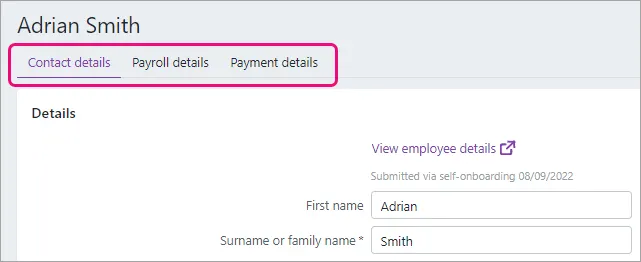
For example:
on the Contact details tab you'll see their personal and contact details
on the Payroll details tab > Superannuation tab you'll see their chosen super fund details (you can also view a completed super choice form)
on the Payroll details tab > Taxes tab you'll see their tax file number and tax table (used to calculate the right amount on their pay)
on the Payment details tab you'll see their bank details
in the Notes field on the Contact details tab you'll see their emergency contact details.
Download a PDF of the employee's submitted details
You can download a PDF containing the employee's submitted details, which you can print or save for your records (Payroll menu > Employees > click the employee's name > Contact details tab > View employee details).
Download a completed super choice form
You can also download a completed Superannuation Standard choice form containing the employee's submitted super details, which you can print or save for your records (Payroll menu > Employees > click the employee's name > Payroll details tab > Superannuation tab > View employee's super choice form).
What about the tax file number declaration form?
With STP Phase 2, a new employee's tax details are sent to the ATO when you declare their first pay run from MYOB, so you won't need to submit a TFN declaration.
FAQs
What does the employee see when I send the self-onboarding form?
The employee will receive an email from noreply@flarehr.com, like this one, containing a link to complete their onboarding. If you entered their mobile number, they'll also receive the link via text message.
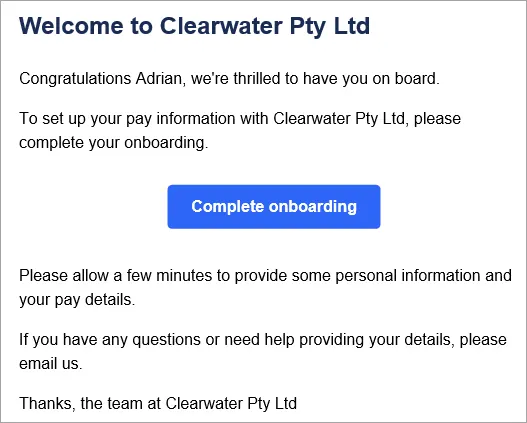
When they click the link, they'll be prompted to authenticate their account. This ensures only the employee can access the secure online form.
The form opens and the employee can complete their details on each tab. They need to complete all mandatory information (marked with an asterisk) on each tab before they can click Save and continue to progress to the next tab, until finally submitting the info.

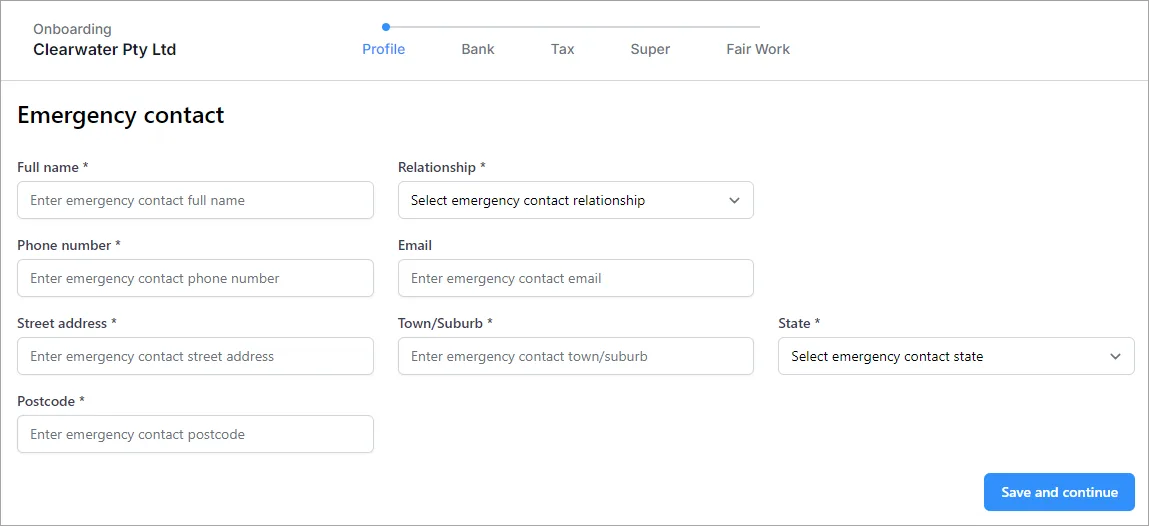
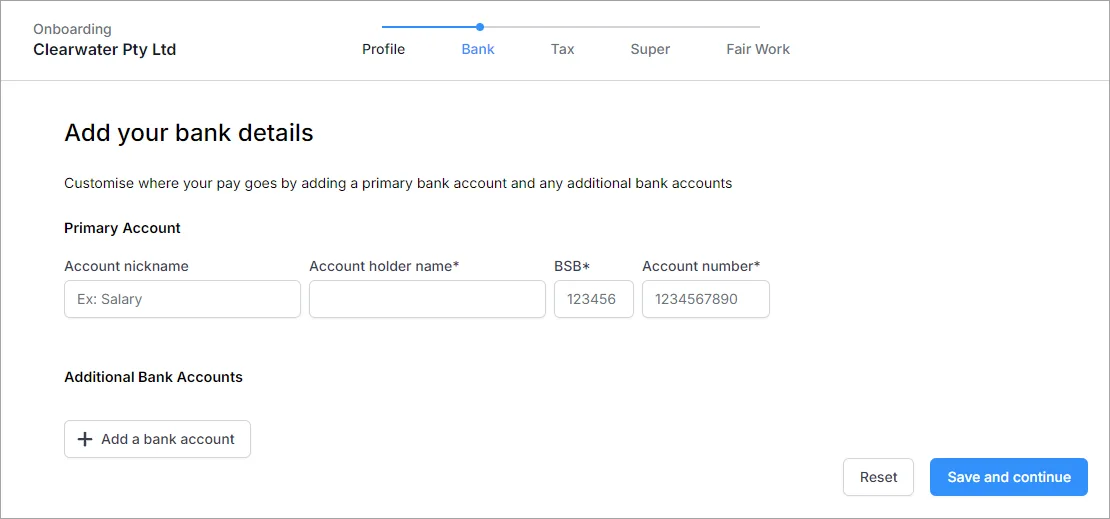

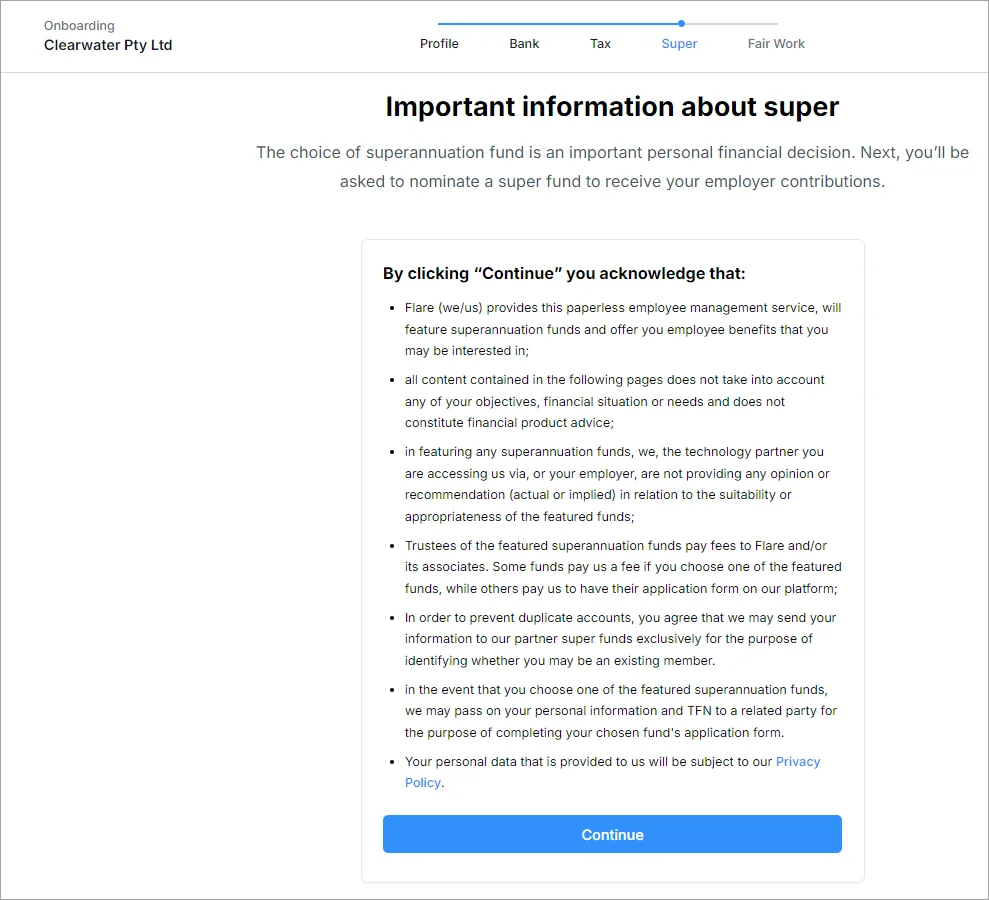
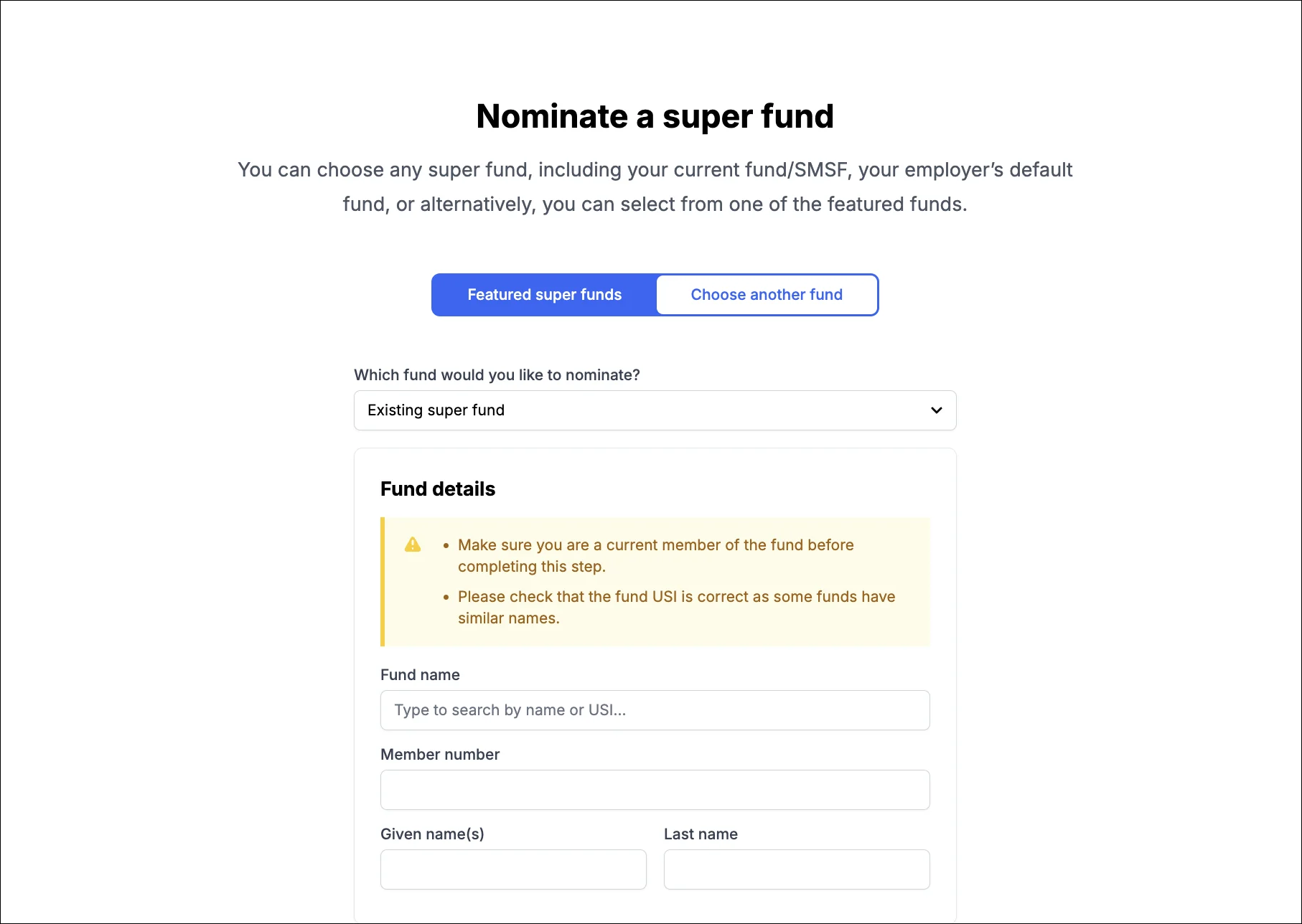
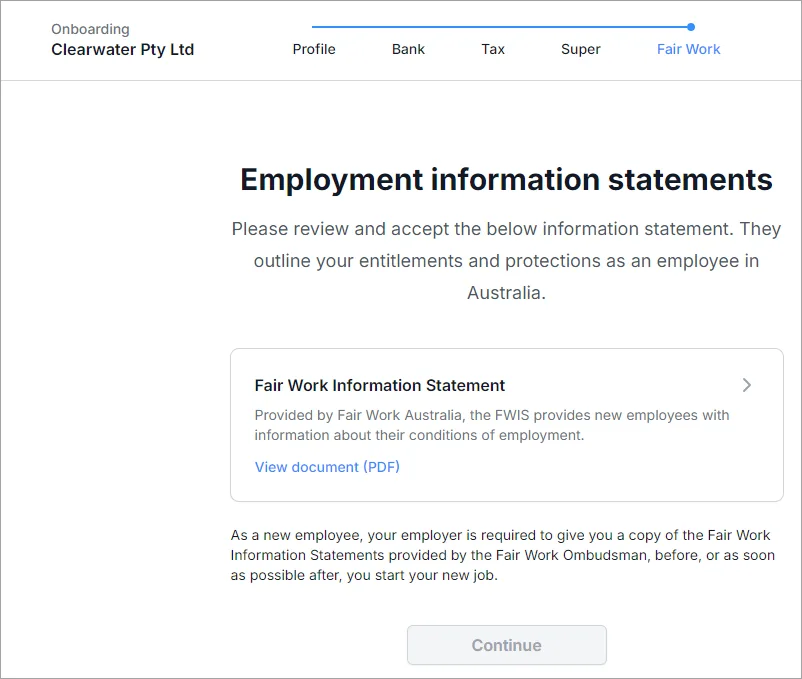
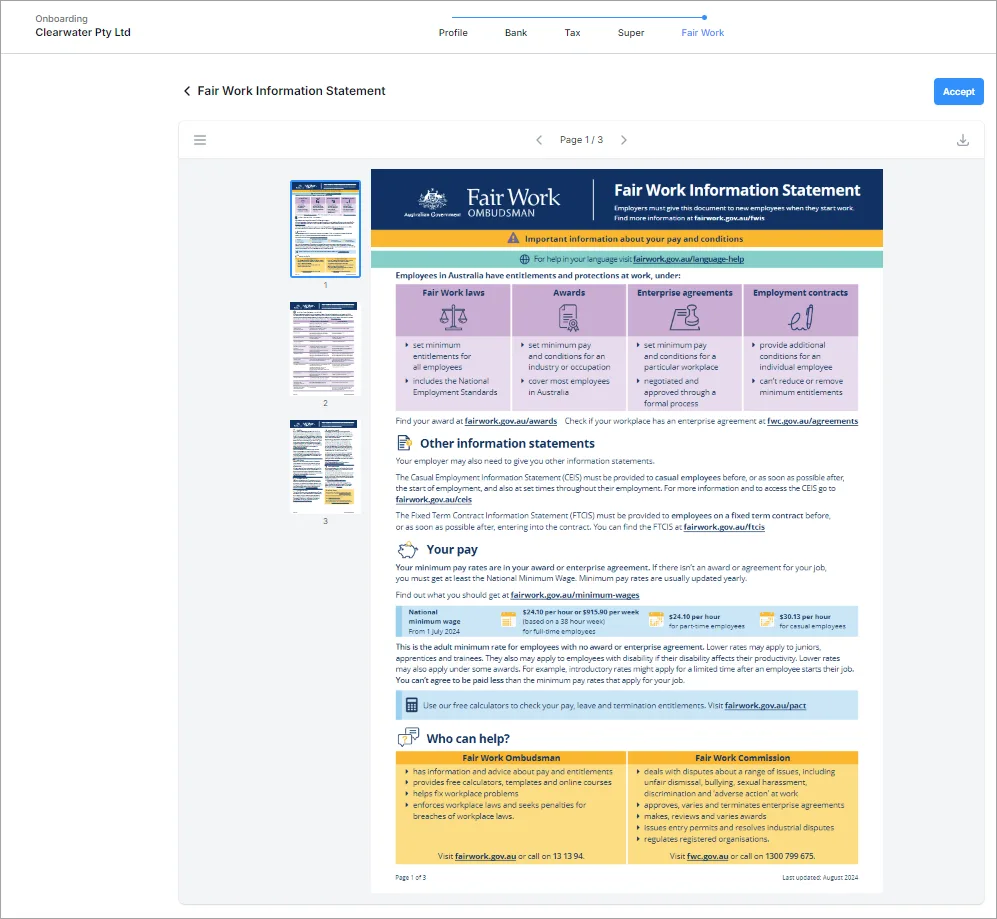
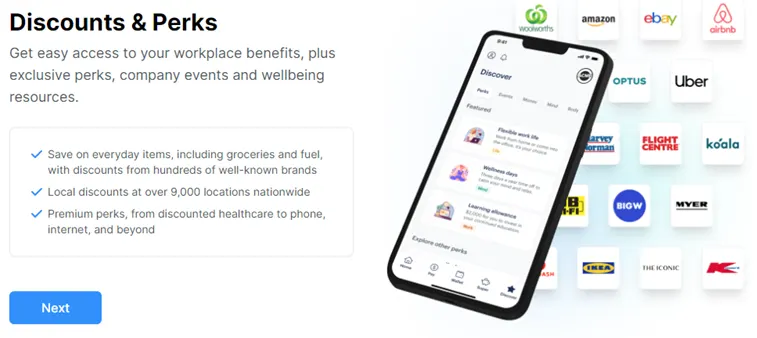
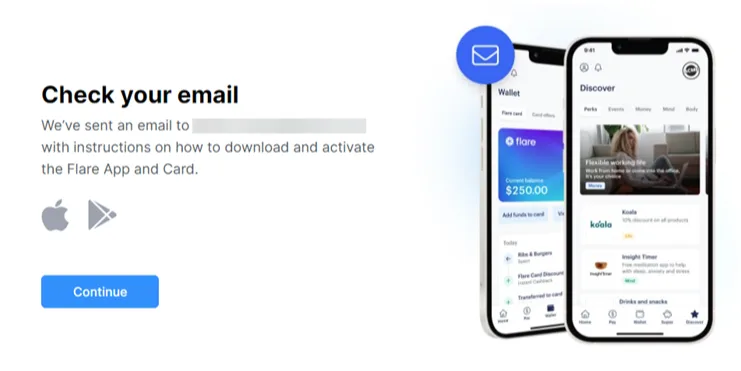
Once the employee has completed all mandatory information, they can click Submit.
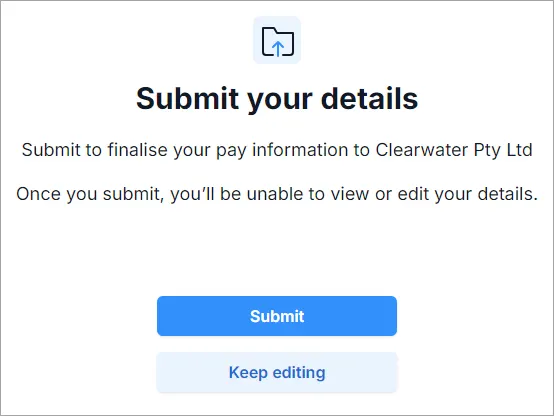
Who is Flare?
Flare is an MYOB company providing workplace solutions to Australian businesses and their employees. Flare Self-Onboarding and Employee Benefits features are available to MYOB Business and AccountRight desktop users.
Learn more about the Flare employee self-onboarding and benefits platform available as part of your MYOB subscription on the Flare website.
Information and privacy
Information collected by using the Self-onboarding and Employee Benefits services are treated in accordance to the MYOB Group privacy disclosure statement and Flare privacy policy.
*This service is provided by Flare, part of the MYOB group.